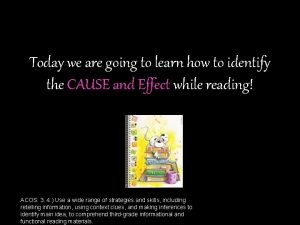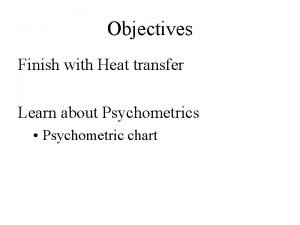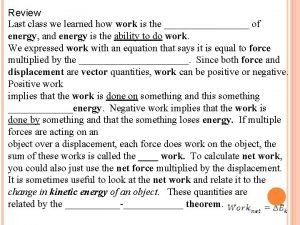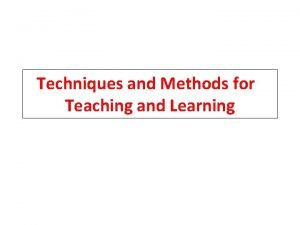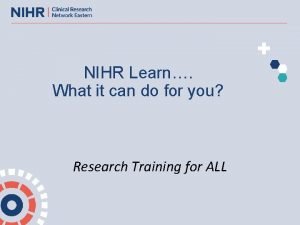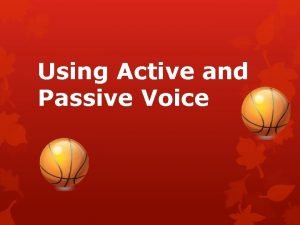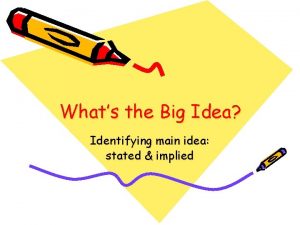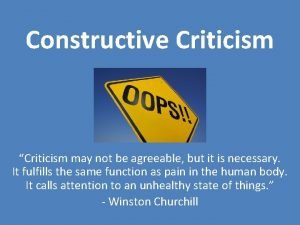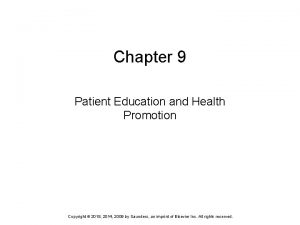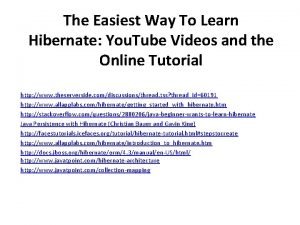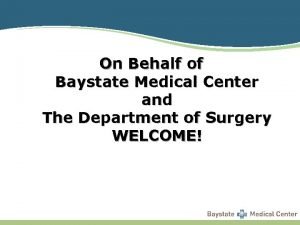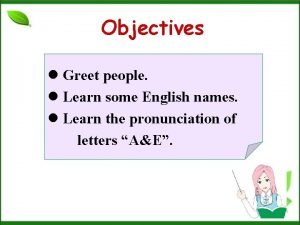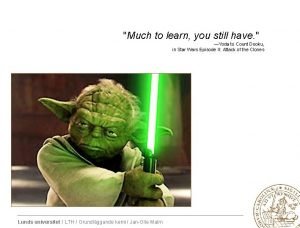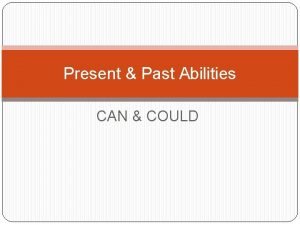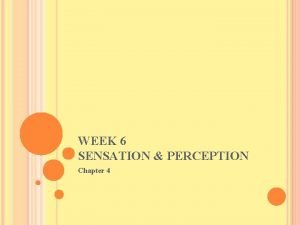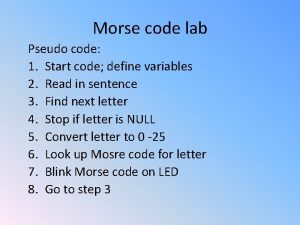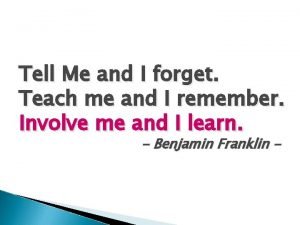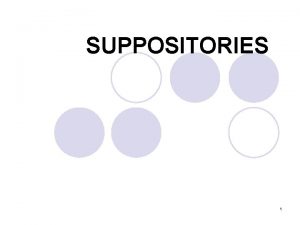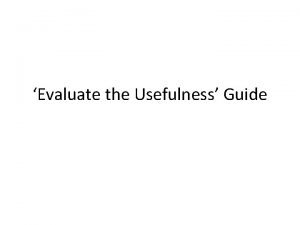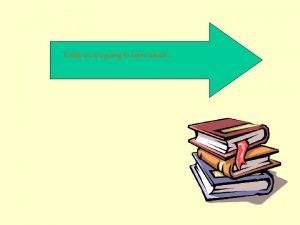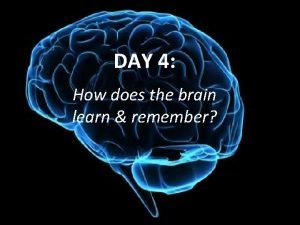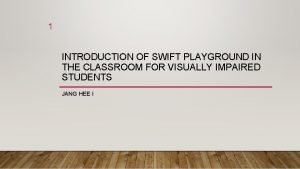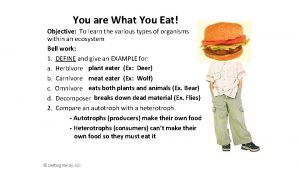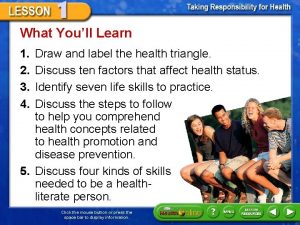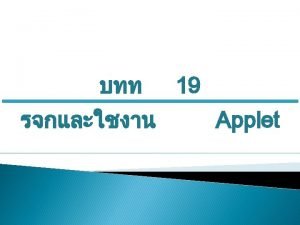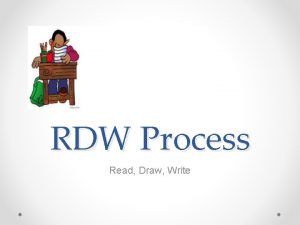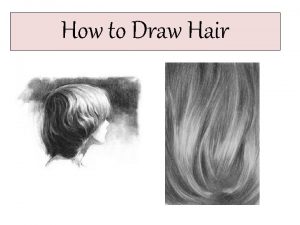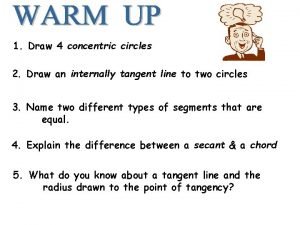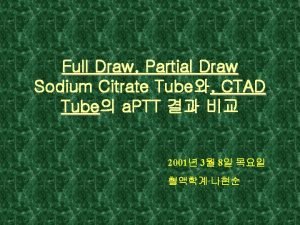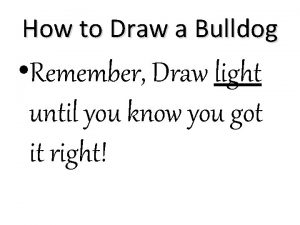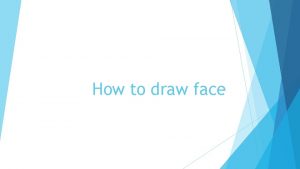What Youll Learn 1 2 3 4 Draw
















































- Slides: 48

What You’ll Learn 1. 2. 3. 4. Draw and label the health triangle. Discuss ten factors that affect health status. Identify seven life skills to practice. Discuss the steps to follow to help you comprehend health concepts related to health promotion and disease prevention. 5. Discuss four kinds of skills needed to be a healthliterate person. Click the mouse button or press the space bar to display information.

Key Terms • • • health mental-emotional health family-social health status health knowledge risk random event wellness health concept health-literate person Click the mouse button or press the space bar to display information.

Your Health • Health is a collective quality of life, that include physical, mentalemotional, and family-social health. Click the mouse button or press the space bar to display information.

What to Know About the Health Triangle • The Health Triangle shows relationships among: – Physical health is the condition of a person’s body. Click the mouse button or press the space bar to display information.

What to Know About the Health Triangle – Mental-emotional health is the condition of a person’s mind and the ways that a person expresses feelings. Click the mouse button or press the space bar to display information.

What to Know About the Health Triangle – Family-social health is the condition of a person’s relationships with family members and with others. Click the mouse button or press the space bar to display information.

What to Know About the Health Triangle Click the mouse button or press the space bar to display information.

What to Know About the Health Triangle • If one of the points on the Health Triangle is missing or impaired, it can begin to lose its balance, which can affect the other two points. Click the mouse button or press the space bar to display information.


Health Status • Health status is the sum of positive and negative influences on a person’s health and well -being. Click the mouse button or press the space bar to display information.

Factors That Affect Health Status 1. Health knowledge – Health knowledge is the information and understanding a person has about health. Click the mouse button or press the space bar to display information.

Factors That Affect Health Status 2. Accessing health information, products, and services – When you access useful health information, you help yourself make decisions about products or services and choose behaviors that will keep you healthy. – A health service is help that is provided by a health-care facility or a health-care provider. – A health product is something that is used to restore or maintain health. Click the mouse button or press the space bar to display information.

Factors That Affect Health Status 3. Behaviors – A person’s behavior is the way a person chooses to act or respond to a situation. – Two types of behavior can affect health: healthful behaviors and risk behaviors. Click the mouse button or press the space bar to display information.

Factors That Affect Health Status Behavior Choices and Health Status Healthful Behavior Risk Behavior • Promotes health • Threatens health • Prevents injury, illness, and premature death • Can cause injury, illness, and premature death • Improves the quality of the environment • Damages or destroys the environment • Examples: wearing a safety belt, exercising regularly, and eating healthful foods • Examples: playing sports without safety equipment, smoking, and drinking alcohol Click the mouse button or press the space bar to display information.

Factors That Affect Health Status 4. Influences such as culture, media, and technology – Many people and circumstances affect your health each day, including: • Culture: the arts, beliefs, and customs that make up a way of life for a group of people at a certain time • Media: various forms of mass communication • Technology: the practical application or use of knowledge Click the mouse button or press the space bar to display information.

Factors That Affect Health Status 5. Communication skills – Communication skills are the ways in which a person chooses to share feelings, thoughts, and information with others. • Resistance skills are methods a person can use to say “no” to an action or situation that could damage health status. • Conflict-resolution skills are steps that you can take to settle a disagreement in a responsible way. Click the mouse button or press the space bar to display information.

Factors That Affect Health Status 6. Decisions involving choices – Many decisions you make have long-term consequences and might cause you to take actions that affect health status. Click the mouse button or press the space bar to display information.

Factors That Affect Health Status TABLE 1. 1 Decisions and Health Status Responsible Decisions Irresponsible Decisions • Promote health • Keep safety in mind • Follow laws • Can harm health • Result in unsafe behaviors • May be illegal • Show respect for self and others • Show disrespect for self and others • Follow guidelines of parents • Show disregard for guidelines and adults of parents and others • Demonstrate good character • Are part of normal character development Click the mouse button or press the space bar to display information.

Factors That Affect Health Status 7. Health-advocacy skills – Health-advocacy skills are used to influence the health behavior and decisions of others and to advance health-related beliefs and concerns. – A health advocate is a person who influences the health behavior and decisions of others and advances certain health-related beliefs and concerns. Click the mouse button or press the space bar to display information.

Factors That Affect Health Status 8. Heredity – Heredity is the passing of characteristics or traits from biological parents to their children. – Inherited characteristics may be protective factors or risk factors. • A protective factor is something that increases the odds of a positive outcome, such as healthful traits. • A risk factor is something that increases the odds of a negative outcome, such as a risk factor for some diseases. Click the mouse button or press the space bar to display information.

Factors That Affect Health Status 9. Your environment – Your environment is everything around you, including the air, the water, and the place in which you live. – An environment can be a protective factor or a risk factor depending on access to basic needs. Click the mouse button or press the space bar to display information.

Factors That Affect Health Status 10. Random events – A random event is an incident over which a person has little or no control. Click the mouse button or press the space bar to display information.

Factors That Affect Health Status Health Skills to Practice for Life You promote the health of others and the quality of the environment when you: • comprehend health concepts related to health promotion and disease prevention; • access information about health products and services; • analyze influences on health, such as culture, media, technology, and other factors; Click the mouse button or press the space bar to display information. • practice healthful behaviors; • use communication skills, resistance skills, and conflict -resolution skills; • set goals and make responsible decisions; • advocate for personal, family, and community health.

Factors That Affect Health Status What decisions can you make to protect your health status? Click the mouse button or press the space bar to display information.

Risks and Random Events • A risk is a chance that has an unknown outcome. • Risks and random events can have positive or negative effects on health status. Click the mouse button or press the space bar to display information.

How Risks Differ From Random Events • Risks – A calculated risk is a chance that a person takes after carefully considering all possible outcomes. – An unnecessary risk is a chance that, after weighing all the possible outcomes, you decide is not worth it. • Random event – A random event is an incident over which a person has little or no control. Click the mouse button or press the space bar to display information.

Responsibility for Health • Quality of life is the degree to which a person lives life to the fullest capacity. • Wellness is the quality of life that results from a person’s health status. • The Wellness Scale is a scale that shows the range in quality of life. Click the mouse button or press the space bar to display information.

How to Use the Wellness Scale • Ten factors (see page 6 in your textbook) can affect your health status and wellness. – Factors that have a positive effect promote optimal wellness. – Factors that have a negative effect increase your risk of illness, injury, and premature death. Click the mouse button or press the space bar to display information.

How to Use the Wellness Scale Click the mouse button or press the space bar to display information.


Comprehending Health Concepts • A health concept is a general idea formed from an understanding of health knowledge. • Health concepts help you apply general ideas to real-life situations. Click the mouse button or press the space bar to display information.

How to Comprehend Health Concepts • There are skills that you can learn and practice that will help you become better at recognizing reliable health information. Click the mouse button or press the space bar to display information.

How to Comprehend Health Concepts TABLE 1. 2 Steps to Comprehend Health Concepts Related to Health Promotion and Disease Prevention The Plan Developing the Life Skill Step 1 Study health information about heart disease. Use valid sources, such as health textbooks and the American Heart Association Web site. You learn that eating broiled foods is more healthful for the heart than eating fried foods. Step 2 Ask questions about heart disease information you don’t understand. Ask your health teacher, physician, or other health expert why eating broiled foods is more healthful for the heart than eating fried foods. They tell you fried foods may contain more saturated fats. A diet high in saturated fats increases the risk of heart disease. Step 3 Use health knowledge to form health concepts to prevent heart disease. The health knowledge you have learned helped you form this concept: I can reduce my risk of heart disease by eating fewer fried foods. Step 4 Use this health concept to reduce your risk of heart disease. When you dine out, you order broiled food instead of fried food. Click the mouse button or press the space bar to display information.

How to Comprehend Health Concepts • You can understand more about any point of the health triangle using the same steps. • Staying informed and asking questions about all aspects of your health will lead to health literacy. Click the mouse button or press the space bar to display information.

Health Literacy • A health-literate person is a person who demonstrates the skills of effective communication, self-directed learning, critical thinking (and problem solving), and responsible citizenship. Click the mouse button or press the space bar to display information.

How to Attain Health Literacy • Everyone can learn to be a health-literate person using effective communication, self -directed learning, critical thinking, and responsible citizenship. Click the mouse button or press the space bar to display information.

How to Attain Health Literacy • Effective communication – Effective communication is expressing your health knowledge, beliefs, and ideas. Click the mouse button or press the space bar to display information.

How to Attain Health Literacy • Self-directed learning – Self-directed learning is taking personal responsibility for gathering and using health-related information. Click the mouse button or press the space bar to display information.

How to Attain Health Literacy • Critical thinking – Critical thinking is evaluating the facts and examining possible outcomes before making decisions. Click the mouse button or press the space bar to display information.

How to Attain Health Literacy • Responsible citizenship – Responsible citizenship is behaving in ways that improve your home, school, community, nation, and world. Click the mouse button or press the space bar to display information.

Study Guide 1. What are three parts of the Health Triangle? The three parts of the health triangle are physical health, mentalemotional health, and family-social health. Click the mouse button or press the space bar to display information.

Study Guide 2. How is a risk different from a random event? A risk is something that you choose whether or not to do. A random event is an incident over which you have little or no control. Click the mouse button or press the space bar to display information.

Study Guide 3. Can you totally control all factors of your health and wellness? Why or why not? No; some factors, such as heredity and random events that occur, are out of your control. You can work to control many factors, such as behaviors and decisions, that will have long-term effects on your health status. Click the mouse button or press the space bar to display information.

Study Guide 4. Match the following descriptions to the skills of a health-literate person. ___ self-directed learning B ___ critical thinking A ___ effective communication D ___ responsible citizenship C A. evaluating the facts and examining possible outcomes before making decisions B. taking personal responsibility for gathering and using health -related information C. behaving in ways that improve your home, school, community, nation, and world D. expressing your health knowledge, beliefs, and ideas Click the mouse button or press the space bar to display information.


Lesson Resources Interactive Tutor Web Links Self-Check Quiz www. glencoe. com Go to www. glencoe. com to find Health & Wellness Web resources.

To navigate within this Interactive Chalkboard product: Click the Forward button to go to the next slide. Click the Previous button to return to the previous slide. Click the Lesson Resources button to go to the Lesson Resources slide where you can access resources, such as transparencies, that are available for the lesson. Click the Menu button to close the lesson presentation and return to the Main Menu. If you opened the lesson presentation directly without using the Main Menu, this will exit the presentation. You also may press the Escape key [Esc] to exit and return to the Main Menu. Click the Help button to access this screen. Click the Health Online Button to access the Web page associated with the particular lesson you are working with. Click the Speaker button to hear the vocabulary term and definition when available.

This slide is intentionally blank.
 Kinetic learning
Kinetic learning Draw near unto me and i will draw unto you
Draw near unto me and i will draw unto you How to draw use case diagram in draw.io
How to draw use case diagram in draw.io What are we going to learn
What are we going to learn Transfer learn
Transfer learn What do you expect to learn
What do you expect to learn What language to learn after spanish
What language to learn after spanish What did we learn last class
What did we learn last class Peek model for readiness to learn
Peek model for readiness to learn Nihr crn learn
Nihr crn learn Learn sydneytafe edu au
Learn sydneytafe edu au Would you rather learn english or french passive voice
Would you rather learn english or french passive voice Build-measure-learn template
Build-measure-learn template How to learn written english by mostafa kamal
How to learn written english by mostafa kamal Did you learn
Did you learn 2 types of main idea
2 types of main idea Understand quran and salah the easy way
Understand quran and salah the easy way Learning to learn
Learning to learn Constructive vs destructive criticism
Constructive vs destructive criticism Chapter 9 patient education and health promotion
Chapter 9 patient education and health promotion Concord examples
Concord examples Ubbi dubbi language
Ubbi dubbi language Learn genetics utah karyotype
Learn genetics utah karyotype How to learn hibernate
How to learn hibernate Learn and share in english 1
Learn and share in english 1 Richard millwood
Richard millwood Learn zims
Learn zims Lattice method addition
Lattice method addition Umms baystate
Umms baystate Innateness hypothesis
Innateness hypothesis Learn to greet
Learn to greet Yoda much to learn you still have
Yoda much to learn you still have Present perfect climb
Present perfect climb Dimitri and linda are trying to learn a new routine
Dimitri and linda are trying to learn a new routine Ascii to morse code
Ascii to morse code Learn english through movies
Learn english through movies Tell me and
Tell me and Evaluation test for suppositories
Evaluation test for suppositories Learn english with jennifer lesson 3
Learn english with jennifer lesson 3 What can we learn from the woopmay orogeny?
What can we learn from the woopmay orogeny? Intention to learn
Intention to learn Today we are going to learn about
Today we are going to learn about The art and science of helping adults learn
The art and science of helping adults learn Want to get into college learn to fail commonlit
Want to get into college learn to fail commonlit How does the brain learn
How does the brain learn What are we going to learn
What are we going to learn Swift playground lesson plans
Swift playground lesson plans Prqrt
Prqrt You are what you learn
You are what you learn



